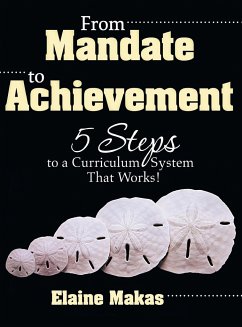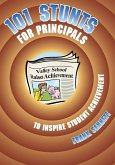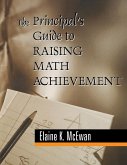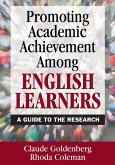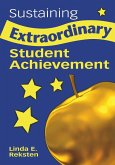Schade – dieser Artikel ist leider ausverkauft. Sobald wir wissen, ob und wann der Artikel wieder verfügbar ist, informieren wir Sie an dieser Stelle.
- Gebundenes Buch
- Merkliste
- Auf die Merkliste
- Bewerten Bewerten
- Teilen
- Produkt teilen
- Produkterinnerung
- Produkterinnerung
Based on a five-step model, this guide helps school leaders establish the processes necessary to align curriculum to mandated standards, develop curriculum maps, and systematize instructional practices.
Andere Kunden interessierten sich auch für
![101 Stunts for Principals to Inspire Student Achievement 101 Stunts for Principals to Inspire Student Achievement]() Frank Sennett101 Stunts for Principals to Inspire Student Achievement35,99 €
Frank Sennett101 Stunts for Principals to Inspire Student Achievement35,99 €![The Principal's Guide to Raising Math Achievement The Principal's Guide to Raising Math Achievement]() Elaine K. McEwanThe Principal's Guide to Raising Math Achievement35,99 €
Elaine K. McEwanThe Principal's Guide to Raising Math Achievement35,99 €![Promoting Academic Achievement Among English Learners Promoting Academic Achievement Among English Learners]() Claude GoldenbergPromoting Academic Achievement Among English Learners39,99 €
Claude GoldenbergPromoting Academic Achievement Among English Learners39,99 €![Sustaining Extraordinary Student Achievement Sustaining Extraordinary Student Achievement]() Linda E. RekstenSustaining Extraordinary Student Achievement29,99 €
Linda E. RekstenSustaining Extraordinary Student Achievement29,99 €![Teaching to Close the Achievement Gap for Students of Color Teaching to Close the Achievement Gap for Students of Color]() Teaching to Close the Achievement Gap for Students of Color62,99 €
Teaching to Close the Achievement Gap for Students of Color62,99 €![Teaching to Close the Achievement Gap for Students of Color Teaching to Close the Achievement Gap for Students of Color]() Teaching to Close the Achievement Gap for Students of Color198,99 €
Teaching to Close the Achievement Gap for Students of Color198,99 €![Closing the Achievement Gap Closing the Achievement Gap]() Tiffany Chane'l AndersonClosing the Achievement Gap10,99 €
Tiffany Chane'l AndersonClosing the Achievement Gap10,99 €-
-
Based on a five-step model, this guide helps school leaders establish the processes necessary to align curriculum to mandated standards, develop curriculum maps, and systematize instructional practices.
Produktdetails
- Produktdetails
- Verlag: Corwin
- Seitenzahl: 250
- Erscheinungstermin: 7. Oktober 2009
- Englisch
- Abmessung: 286mm x 221mm x 18mm
- Gewicht: 898g
- ISBN-13: 9781412963787
- ISBN-10: 1412963788
- Artikelnr.: 26377340
- Herstellerkennzeichnung
- Libri GmbH
- Europaallee 1
- 36244 Bad Hersfeld
- gpsr@libri.de
- Verlag: Corwin
- Seitenzahl: 250
- Erscheinungstermin: 7. Oktober 2009
- Englisch
- Abmessung: 286mm x 221mm x 18mm
- Gewicht: 898g
- ISBN-13: 9781412963787
- ISBN-10: 1412963788
- Artikelnr.: 26377340
- Herstellerkennzeichnung
- Libri GmbH
- Europaallee 1
- 36244 Bad Hersfeld
- gpsr@libri.de
Elaine Makas Howard has 25 years of experience in education. She has served numerous districts in Michigan in curriculum, career development and counseling processes as a regional director of Instructional Services. She is also a systems consultant with Curriculum Connections, a business she co-owns. Ms. Howard has a specialist degree from Saginaw Valley State University in Educational Leadership with an emphasis on curriculum. She has a master's degree from Central Michigan University in school guidance and a bachelor's degree from Western Michigan University in history. She is certified in central office and secondary administration, counseling, and 7-12 social studies secondary education. Ms. Howard's work experience includes secondary teacher, community education director, and curriculum consultant. She lives in Cass City, Michigan with three of her four sons.
Acknowledgments
About the Author
Introduction
Part I. Foundations of Purpose and Implementation
1. An Introduction to Teacher-Led Curriculum Processes: The DAILY
Curriculum System
2. A Brief Theoretical Foundation: Why Build a Curriculum System Through
Teacher-Led Processes?
3. Getting Ready: Planning for the Components of the DAILY Curriculum
System
Part II. A Planned Journey of Curriculum Processes
4. Data First: What Is Our Data Telling Us About Our Teaching and Our
Students?
5. Curriculum Alignment: Do We Have a Match Between Standards and
Instruction?
6. Developing Instructional Goals: Keeping a Bridge Between Curriculum
Processes and Instruction
7. Creating Curriculum Maps: The Connection Between Instruction and
Standards
8. Instructional Pace Guides: Adding Instructional Depth With Key Concepts
and Essential Questions
9. The Final Link: Building Local Common Assessments
Part III. Maintaining Stability and Success
10. Creating Stability: Sustaining, Monitoring, and Adjusting a Curriculum
Process System
Conclusion: Reflections on a Curriculum System
Resource A: Further Reading
Resource B: Sample Agendas
Resource C: Blank Forms
Resource D: Sample Curriculum Maps
Resource E: Sample Local K?8 Common Assessment Manual for English Language
Arts and Mathematics
References
Index
About the Author
Introduction
Part I. Foundations of Purpose and Implementation
1. An Introduction to Teacher-Led Curriculum Processes: The DAILY
Curriculum System
2. A Brief Theoretical Foundation: Why Build a Curriculum System Through
Teacher-Led Processes?
3. Getting Ready: Planning for the Components of the DAILY Curriculum
System
Part II. A Planned Journey of Curriculum Processes
4. Data First: What Is Our Data Telling Us About Our Teaching and Our
Students?
5. Curriculum Alignment: Do We Have a Match Between Standards and
Instruction?
6. Developing Instructional Goals: Keeping a Bridge Between Curriculum
Processes and Instruction
7. Creating Curriculum Maps: The Connection Between Instruction and
Standards
8. Instructional Pace Guides: Adding Instructional Depth With Key Concepts
and Essential Questions
9. The Final Link: Building Local Common Assessments
Part III. Maintaining Stability and Success
10. Creating Stability: Sustaining, Monitoring, and Adjusting a Curriculum
Process System
Conclusion: Reflections on a Curriculum System
Resource A: Further Reading
Resource B: Sample Agendas
Resource C: Blank Forms
Resource D: Sample Curriculum Maps
Resource E: Sample Local K?8 Common Assessment Manual for English Language
Arts and Mathematics
References
Index
Acknowledgments
About the Author
Introduction
Part I. Foundations of Purpose and Implementation
1. An Introduction to Teacher-Led Curriculum Processes: The DAILY
Curriculum System
2. A Brief Theoretical Foundation: Why Build a Curriculum System Through
Teacher-Led Processes?
3. Getting Ready: Planning for the Components of the DAILY Curriculum
System
Part II. A Planned Journey of Curriculum Processes
4. Data First: What Is Our Data Telling Us About Our Teaching and Our
Students?
5. Curriculum Alignment: Do We Have a Match Between Standards and
Instruction?
6. Developing Instructional Goals: Keeping a Bridge Between Curriculum
Processes and Instruction
7. Creating Curriculum Maps: The Connection Between Instruction and
Standards
8. Instructional Pace Guides: Adding Instructional Depth With Key Concepts
and Essential Questions
9. The Final Link: Building Local Common Assessments
Part III. Maintaining Stability and Success
10. Creating Stability: Sustaining, Monitoring, and Adjusting a Curriculum
Process System
Conclusion: Reflections on a Curriculum System
Resource A: Further Reading
Resource B: Sample Agendas
Resource C: Blank Forms
Resource D: Sample Curriculum Maps
Resource E: Sample Local K?8 Common Assessment Manual for English Language
Arts and Mathematics
References
Index
About the Author
Introduction
Part I. Foundations of Purpose and Implementation
1. An Introduction to Teacher-Led Curriculum Processes: The DAILY
Curriculum System
2. A Brief Theoretical Foundation: Why Build a Curriculum System Through
Teacher-Led Processes?
3. Getting Ready: Planning for the Components of the DAILY Curriculum
System
Part II. A Planned Journey of Curriculum Processes
4. Data First: What Is Our Data Telling Us About Our Teaching and Our
Students?
5. Curriculum Alignment: Do We Have a Match Between Standards and
Instruction?
6. Developing Instructional Goals: Keeping a Bridge Between Curriculum
Processes and Instruction
7. Creating Curriculum Maps: The Connection Between Instruction and
Standards
8. Instructional Pace Guides: Adding Instructional Depth With Key Concepts
and Essential Questions
9. The Final Link: Building Local Common Assessments
Part III. Maintaining Stability and Success
10. Creating Stability: Sustaining, Monitoring, and Adjusting a Curriculum
Process System
Conclusion: Reflections on a Curriculum System
Resource A: Further Reading
Resource B: Sample Agendas
Resource C: Blank Forms
Resource D: Sample Curriculum Maps
Resource E: Sample Local K?8 Common Assessment Manual for English Language
Arts and Mathematics
References
Index

